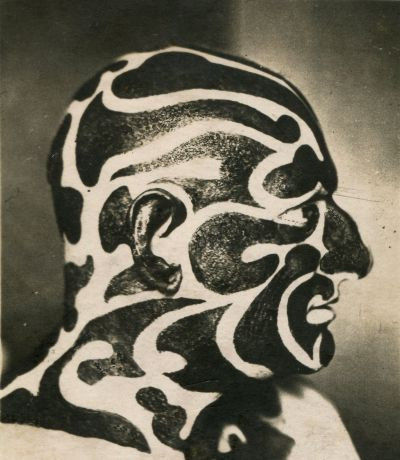The Deep Blue Canvas: The Maritime History of Tattoos and Superstitions
- thebluebloodstudios

- Jun 17
- 4 min read
Updated: Jun 25
For centuries, the vast, unpredictable ocean wasn't just a place to travel; it was a living, breathing entity, a highway, yes, but also a formidable, often terrifying, adversary. Sailors, constantly at the mercy of winds and waves, developed a unique culture steeped in tradition, hard work, and a healthy dose of superstition. And when it came to showing that off, nowhere was it more visible than on their skin. Long before tattoos became a mainstream art form we all know and love, they were the permanent marks of a life at sea; a visual logbook of voyages, a hard-earned badge of honor, and, perhaps most importantly, a powerful set of talismans against the ocean's countless dangers.
Funnily enough, the very word "tattoo" itself has maritime roots, coming from the Polynesian word "tatau." It was brought back to the West by Captain James Cook's voyages in the late 18th century. His crew, utterly fascinated by the intricate body art of Tahitians, quickly embraced the practice. Before long, European and American sailors became the first Westerners to really popularize these permanent etchings, often learning to apply them themselves during those long, often boring, hours at sea.
But here’s the thing: these weren't just decorative souvenirs or idle doodles. Every single design carried a profound meaning, deeply woven into the fabric of maritime life and its pervasive superstitions.
Navigating Home: Symbols of Guidance and Protection
Life at sea was inherently risky, and sailors would grasp at any advantage, no matter how mystical, to ensure they made it back home safe and sound.
The Nautical Star: This five-pointed star, often rendered with alternating colors like a compass rose, was a crucial symbol for finding your way. Just as sailors relied on the North Star for navigation, this tattoo was believed to keep them on course, literally and figuratively, making sure they'd always find their way home.
The Compass Rose: Much like the nautical star, a compass tattoo was a powerful good luck charm. The belief was that it would stop a sailor from getting lost and guide them safely back to port and their loved ones.
Swallows: These delicate birds are probably one of the most iconic sailor tattoos out there. A single swallow typically meant 5,000 nautical miles traveled – a huge accomplishment in the days of sailing ships. Two swallows might mark 10,000 miles, often placed on opposite shoulders. While the exact mileage can vary slightly depending on the specific tradition or time period, these numbers are most commonly cited. Beyond just miles, swallows are known for their incredible migrations and always returning to their nesting sites, making them potent symbols of a safe journey home. There was even a superstition that if a sailor was lost at sea, the swallows would carry their soul up to heaven.
Anchors: The anchor, the most secure thing on a ship, naturally became a strong symbol of stability, hope, and steadfastness. Often, an anchor would feature the name of a loved one, a constant reminder of what kept the sailor grounded and longing for home. It also traditionally marked a successful Atlantic crossing.
Defying the Dangers: Talismans Against the Deep
The ocean wasn't just a path; it often felt like a hungry beast. Sailors faced terrifying storms, devastating shipwrecks, and the constant, chilling threat of drowning. Their tattoos often served as a form of spiritual armor against these dangers.
Pigs and Roosters: These might seem like the oddest sailor tattoos, often found on the feet (pig on the left, rooster on the right), but they were firmly believed to prevent drowning. The superstition actually gained significant traction during World War II, when these farm animals, shipped in wooden crates, would often float to shore after a shipwreck, sometimes becoming the only survivors. While this association is strong from that era, the general superstition likely has roots that predate it, as sailors have long been superstitious about animals on board. Sailors hoped the animals' uncanny survival would somehow rub off on them.
Crosses on the Feet: Placed on the soles of the feet, crosses or crucifixes were thought to ward off sharks if a sailor happened to fall overboard.
"Hold Fast" Knuckle Tattoos: Seen across the knuckles, "Hold Fast" was both a direct command and a powerful mantra. It was believed to literally give sailors a stronger grip on the rigging during rough weather, embodying sheer resilience and the determination to ride out any storm. Interestingly, some sources suggest this tattoo might have originally marked an oarsman before it became more widespread among all sailors.
Propellers: A more extreme, and frankly, a bit quirky, superstition involved propellers (or "screws") tattooed on each buttock. The idea was that these would "propel" the sailor back home safely, or at the very least, keep them afloat.
Milestones and Memories: Marking a Life's Journey
Beyond superstition, tattoos were also a permanent record of a sailor's experiences and impressive achievements.
Full-Rigged Ships: This majestic symbol of a life spent at sea often meant that a sailor had successfully rounded Cape Horn, one of the most dangerous and challenging maritime passages in the entire world.
Crossed Cannons: This design clearly indicated naval military service, a badge of honor for those who had seen combat.
Harpoons: For whalers and fishermen, a harpoon marked their specific, often perilous, trade.
Dragons: A golden dragon usually meant crossing the International Date Line, entering the "realm of the golden dragon" (Asia), or more generally, service in the Pacific.
From warding off evil spirits to charting their incredible journeys, the tattoos on a sailor's body were a powerful visual narrative, a testament to their bravery, their deep-seated beliefs, and their enduring, often tense, connection to the unpredictable embrace of the sea. These designs, born of necessity and old lore, continue to resonate today, carrying the powerful legacy of the deep blue canvas.


















Comments